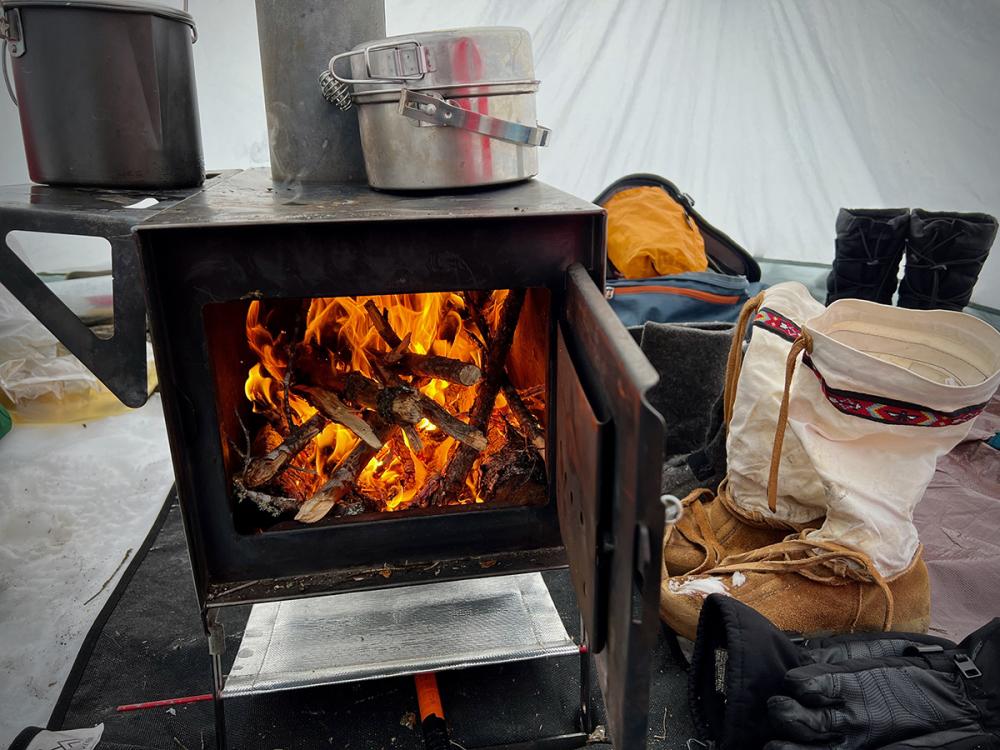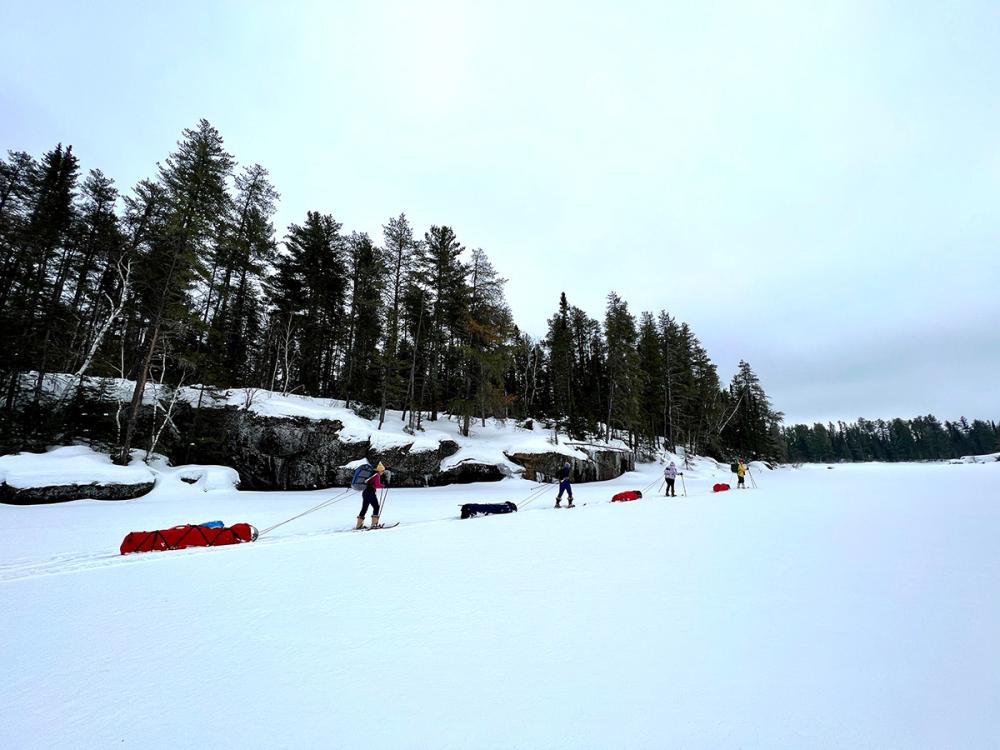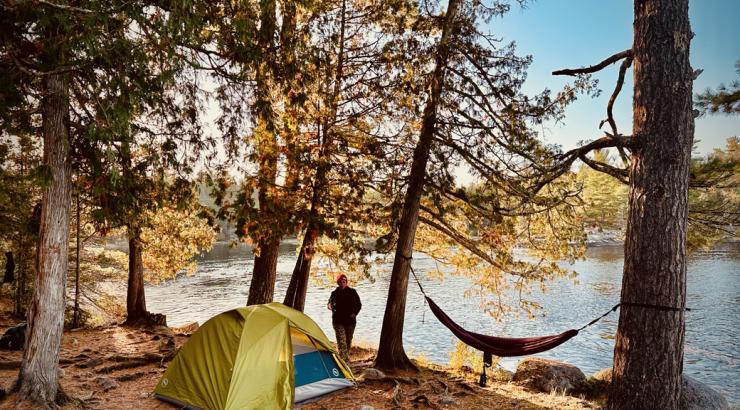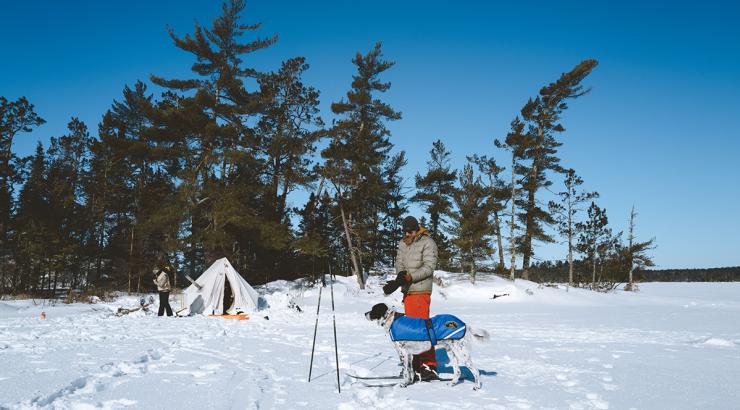Interested in planning a winter camping trip but not sure where to start? We’ve put together helpful resources and packing lists to guide you. You’ll also find a list of outfitters who can help you plan your adventure or offer guided services. Many of them will rent you gear for winter camping or winter day trips.
WHAT TO PACK FOR WINTER CAMPING
We’ve put together a selection of winter camping packing lists with help from some of our favorite outfitters and guides!
GROUP GEAR LIST
General
-
Toboggan or pulk sled with harness
-
Hot Tent or 3-season tent
-
Stove or backpacking stoves
-
Backcountry or classic skis or snowshoes, poles
-
Waterproof Maps/compass or GPS device
-
Ice chisel or auger
-
Tarps and ropes
-
Sleeping Bag (rated 10-20° warmer than expected temps)
-
Sleeping Pad (2-3 or use a winter pad or cot)
-
Pillow (optional)
-
Duffels, waterproof dry bags
-
Headlamp/Camplight
Kitchen
-
Backpacking stove with fuel (use white gas)
-
Coffee
-
Water Bottle - Thermos/Nalgene (2 per person), can double as a water collection from ice hole
-
Cook Kit (pans, pots, spatula, measuring cups, bowls, serving spoon, etc.)
-
Utensils (forks, spoons, knives, plates)
-
Aluminum foil (depending on meal)
-
Biodegradable soap (can not go into the lake, toss into the woods), scrubbie, collapsible wash bucket
-
Food: Pack and prepare all food ahead of time. Choose high-calorie, high-fat food. Organize by meal in a duffle or hard-sided bin for ease of transport.
-
Food hanging system or an Interagency Grizzly Bear Committee certified bear-resistant container*. Required March 1 - November 1.
Other, Personal Gear
-
Pack saw/hatchet/axe (practice using ahead of time)
-
Body wipes (pack out)
-
Toilet paper (Dump into latrine or pack out)
-
Hand sanitizer
-
Garbage bags (pack out all garbage)
-
Matches (waterproof are essential), Lighters (may not work in extremely cold conditions)
-
Hygiene & toiletries (+ extra baggies as all hygiene or menstrual products must be packed out)
-
Clothes (Pack wool, wool blends, fleece, and synthetic)
-
2 Pairs of winter boots (1 pair for travel, 1 pair for camp). Extra removable liners a plus.
-
Warm socks (wool, wool blend, boot length)
-
Wool or wool blend baselayers (2 pairs)
-
Anorak or Gore-Tex winter shell
-
Wool pants or ski pants
-
Fleece jacket, wool sweater
-
Clothing for inside the hot tent or additional clothing if you're cold camping.
-
2 Insulated hats
-
Sunglasses, ski goggles
-
Pocketknife or multitool
-
Sunscreen
-
Headlamp/flashlight
-
Repair kit: duct tape, zip ties, cordage, extra pieces for sleds/skis (optional)
-
First aid kit: pack for winter injury or illness (frostbite, chemical hand/foot warmers, burns/cuts, snow blindness, cold-related illness, hypothermia)
-
Water: Collect water through a hole in the ice, boil
Fun optional items
-
Sit pad or chair (recommended)
-
Playing cards
-
Binoculars
-
Book
-
Camera
-
Ice fishing gear
-
Beverages (NOT in glass or aluminum cans.)
-
All electronics should be kept warm and stored in a bag and tossed into a sleeping bag at night.
Contact one of these northern MN Boundary Waters Business Coalition members to help you plan & outfit your winter camping trip:
- Piragis Northwoods Company, Ely (rents winter camping gear, guided winter trips)
- Cast Outdoors Adventures, Ely (guided winter trips)
- Voyageur North Outfitters, Ely (rents ice fishing equipment only)
- Wintergreen Northern Wear, Ely (rents outerwear)
- Sawtooth Outfitters, Tofte (rents winter camping gear)
- University of Duluth RecWell Department, Duluth (rents snowshoes, skate and classic skis, kicksleds)
- Northern Goods, Grand Marais, (rents snowshoes, backcountry skis, and classic skis)
Do you just need a little help with route planning maps? Try Paddle Planner. It’s a great route-planning tool (and many outfitters use it too!)
* In May of 2024, the USFS added the BWCAW Bear Aware Food Storage Order between March 1 and November 30, effective April 19, 2024, through April 19, 2026. To reduce the chances of attracting wildlife, attractants should be suspended at least 12 feet above the surface of the ground and 6 feet horizontally from the trunk of a tree or stored in an Interagency Grizzly Bear Committee-certified bear-resistant container. Attractants are any items that have a strong odor and may attract bears and other wildlife, such as food, food containers, scented items (such as soap, lip balm, toothpaste), and refuse. Learn more here.





